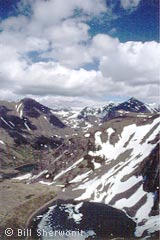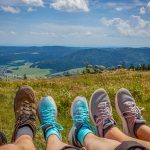 Friday afternoon, late April. End of a busy workweek — so busy that I’ve kept myself sequestered indoors, despite six straight days of glorious sunshine and springtime warmth. Today, finally, I leave my hurried, too-much-to-do city life and head for the hills. After too long away, I return to Anchorage’s backyard wilderness, Chugach State Park. Back to visit an old friend: 3,550-foot Flattop Mountain.
Friday afternoon, late April. End of a busy workweek — so busy that I’ve kept myself sequestered indoors, despite six straight days of glorious sunshine and springtime warmth. Today, finally, I leave my hurried, too-much-to-do city life and head for the hills. After too long away, I return to Anchorage’s backyard wilderness, Chugach State Park. Back to visit an old friend: 3,550-foot Flattop Mountain.
Huffing and puffing, sweating heavily in 50-degree air, I slog my way up Flattop’s still snowy trail. Following bootprints of other hikers through mud and slush, I experience a strong sense of dij` vu. The feeling, however, seems less eerie than inevitable: I have indeed passed this way many times before. Enough times that my feet have almost memorized the trail’s twists and turns.
Within forty-five minutes, I’m on the mountain’s top and gazing across a huge chunk of Southcentral Alaska: 120 miles to the north, the skyline is dominated by the Alaska Range’s twin giants, 20,320-foot Denali (or Mount McKinley) and 17,400-foot Mount Foraker; while nearly 100 miles to the southwest is Mount Redoubt’s volcanic cone. More immediately below me are the Anchorage Bowl and Cook Inlet. And along my eastern horizon, stretching south to north, are the Chugach Mountains: alpine wilderness on the eastern doorstep of Anchorage, Alaska’s largest city, a quarter million strong and growing.
A brisk wind usually whips across Flattop’s summit, but today the air is calm. There’s no other sound but my breathing until a flock of honking geese flies overhead. Once the geese pass, there’s not a creature in sight. No Dall sheep. No ravens or ptarmigan. No people. All the solitude I could ever want.
Later, returning to the trailhead, I meet at least a dozen people bound for the summit. There’s a busyness to the mountain now, signaling the approach of summer. Within a month or two, such warm and sunny days will lure crowds of people to Flattop. By September, 8,000 to 10,000 people — preschoolers, senior citizens, solitary hill-runners, curious tourists, and hardcore mountaineers — will have scrambled up its trails.
In a state with nineteen peaks above 14,000 feet and seventeen of the nation’s twenty highest mountains, Flattop is a mere bump. But locally this sawed-off mountain has an extraordinary allure. Less than fifteen miles from downtown Anchorage and visible throughout the city, Flattop is easy to find, easy to reach and, as mountains go, easy to climb. From the main trailhead, it’s only one and a half miles and 1,350 feet in elevation gain to the summit. And in summer, no climbing expertise is needed; the ascent is more of a strenuous hike, with some rock scrambling necessary near the top (that’s not to say the mountain can’t pose dangers; a handful of people have died on its slopes). Nearly all of Anchorage’s residents, it seems, have climbed Flattop, or at least tried. And enough have succeeded to make it easily the most-climbed mountain in Alaska.
For many, Flattop is the initial lure to the 495,000-acre”accessible wilderness” east of Anchorage. Established in 1970, Chugach State Park encloses the western edge of the Chugach Mountains, a 300-mile-long coastal range that arcs from Cook Inlet almost to the Canadian border. Measured in absolute numbers, the Chugach Range is not especially grand; its tallest peak, Mount Marcus Baker (east of the park) is only 13,176 feet high. But measured from base to summit, the Chugach is Alaska’s second-highest coastal range. These mountains also give birth to 8,200 square miles of glacial ice, more than a quarter of the state’s total.
Article Contributor:Bill Sherwonit



